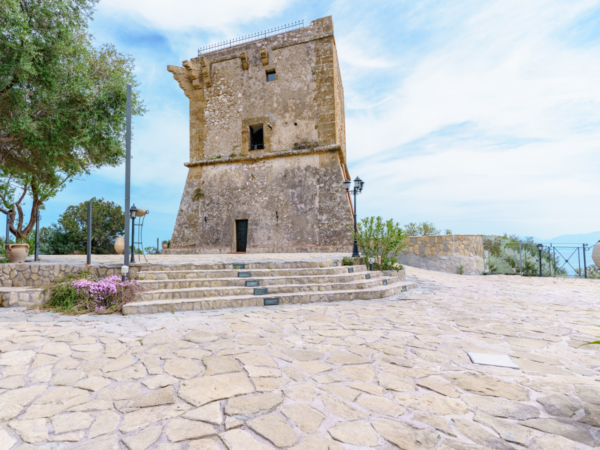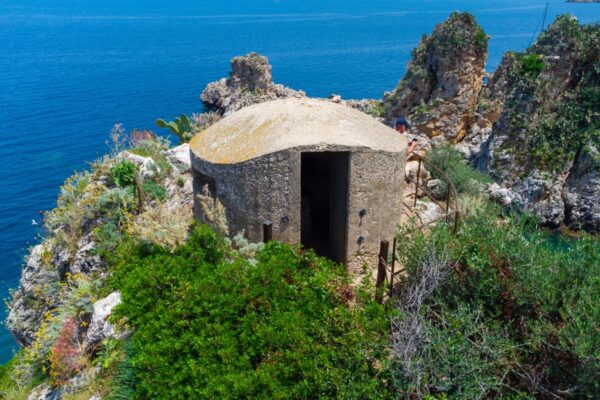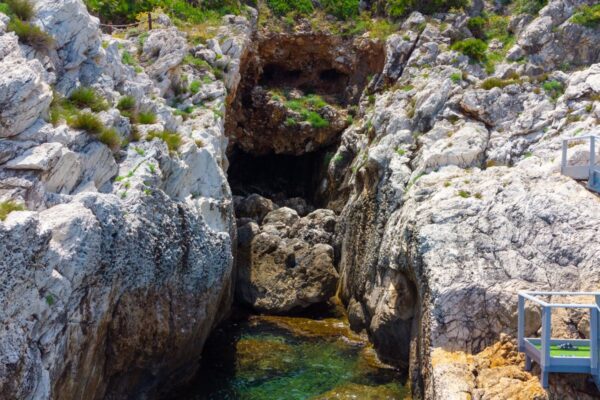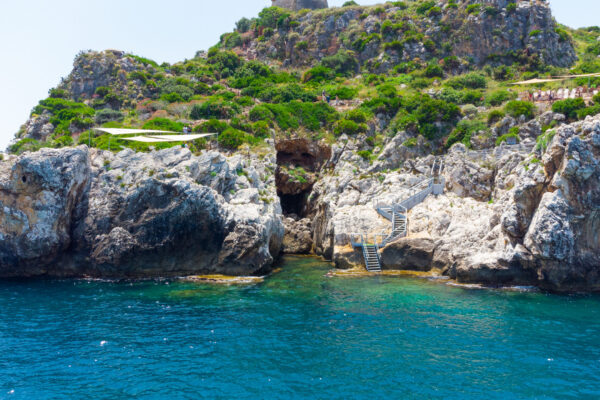Torre di Scopello:
a centuries-old history
Torre di Scopello:
a centuries-old history
This stretch of coastline, which was once occupied by the ancient Cetaria, probably a commercial emporium of Greek origin, whose exact location remains unclear, was named Scopello, from the Greek Σκόπελος (Scopelos) meaning rock or cliff, due to the significant presence of Faraglioni that still fascinate visitors today.
Scopello was a crossroads of peoples and dominations: it followed the Greek era, then the Roman period, after the acquisition of Sicily as a province in 241 BC at the end of the First Punic War; it was followed by the Islamic period, traces of which can be found in the underwater museum right on the seabed of the Faraglioni of Scopello; the Regnum Siciliae, which included among its main exponents Frederick II of Swabia until the period when the territory of Scopello became a hunting estate of Ferdinand II of Bourbon until the Expedition of the Thousand and all the events that led to the Unification of Italy in 1861.
Torre Doria: from the Kingdom of Sicily to the Royal Italian Army
Its strategic position allowed it to communicate with other towers through smoke signals called 'Fani.
In 1578, the Spanish Deputation commissioned the architect and military engineer Tiburzio Spannocchi to study the territory for the correct placement of the positions subsequently designed by the renowned Florentine architect Camillo Camilliani, who, even before specializing in military engineering, worked with his father on the Fontana Pretoria located in front of the Senate Palace in Palermo (Palazzo delle Aquile).
The construction of the Doria Tower began in 1595, and upon its completion in 1602, it officially started fulfilling its function of coastal defense with maximum efficiency.
At the end of the incursions, the towers were gradually abandoned, but pages of history are still dedicated to the Tower of Scopello: in 1939, Italy prepares for entry into war.
Torre Doria: from the Kingdom of Sicily to the Royal Italian Army
Its strategic position allowed it to communicate with other towers through smoke signals called 'Fani.
In 1578, the Spanish Deputation commissioned the architect and military engineer Tiburzio Spannocchi to study the territory for the correct placement of the positions subsequently designed by the renowned Florentine architect Camillo Camilliani, who, even before specializing in military engineering, worked with his father on the Fontana Pretoria located in front of the Senate Palace in Palermo (Palazzo delle Aquile).
The construction of the Doria Tower began in 1595, and upon its completion in 1602, it officially started fulfilling its function of coastal defense with maximum efficiency.
At the end of the incursions, the towers were gradually abandoned, but pages of history are still dedicated to the Tower of Scopello: in 1939, Italy prepares for entry into war.
The Casamatta of Torre di Scopello
The Casamatta of Torre di Scopello
Vasca della Regina
Its fame derives from an ancient legend that particularly captivates visitors who descend to plunge into the crystalline waters of the Faraglioni of Scopello and observe this petrified figure inside this enchanting cove.
Experiences, initiatives and future projects
In 2021, in line with the entrepreneurial philosophy adopted for the enhancement and preservation of the landscape, we initiated a project aimed at the proper use of the territory and Sustainable Tourism. This project led to the opening of the Public Coastal Nature and History Trail of the Tower of Scopello, inaugurated on July 29 of the same year.
In July 2022, two culturally significant events took place, drawing a large audience: on July 13, the play “Quattro giorni all’ultima luna” (“Four Days at the Last Moon”) was staged, a theatrical performance conceived by Francesca Mercadante and promoted by the Palermo UNESCO Club. The play revolves around a Mediterranean legend that circulated in northern courts, written by the Armenian poet Al Himyari in the late 14th century, portraying the resistance of Sikilla against Frederick II of Swabia at the end of the centuries-long history of Muslims in Sicily. The subsequent event on July 22 was a convention on the island’s defense systems titled “Presidi militari: dal Camilliani al Regio esercito” (“Military Outposts: From the Camilliani to the Royal Army”), which included an exhibition of revolutionary vehicles used in the 1943 landing, including the original models of the Jeep Willys. The event featured the direct participation of historians and researchers Pippo Lo Cascio, Attilio Albergoni, Flavio Messina, a member of G.R.S.S.O. “Ricostruzione eventi bellici in Sicilia,” as well as expert collectors Francesco Giustiniano and Davide Giammanco.
On June 25, 2023, a different yet equally captivating event took place, a charity fashion show, all-female, with the proceeds from ticket sales donated to Loto OdV for ovarian cancer research and the services the association provides to patients during their treatment journey. The show featured the involvement of the Milanese fashion designer Martino Midali, whose creations, characterized by soft and enveloping lines, were worn by twenty-nine non-professional models, including oncology patients and doctors.
Furthermore, in 2023, we embarked on a project to map, maintain, expand, and catalog the various plant species on the property, in order to study their changes, safeguard their evolutionary stages, and collect information and curiosities related to specific tree and shrub species. This data will be used for the creation of dissemination and information tools, with the scientific advice of the Director of the Palermo Botanical Garden, Dr. Rosario Schicchi, and Agronomist Dr. Enrico Russo.







